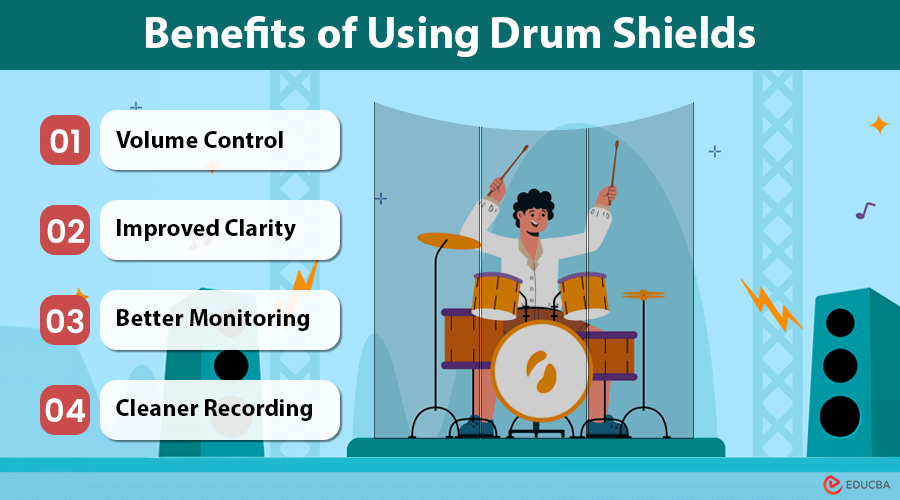Essential Equipment for Better Sound Control
If you have ever been in a band or attended a live performance, you know how loud drums can get. While the sound of a drum set is energetic and powerful, it can sometimes overwhelm other instruments or distort the overall balance of the music. This is where drum shields come into play. They are essential for managing sound levels, whether live or in a studio recording.
A PD’s Drum Shield does not just help with sound control; it enhances the overall experience for musicians and the audience. Isolating the drum sound creates a balanced mix and allows every instrument and voice to stand out clearly. At Pennzoni Display, you will find a variety of drum shields designed to meet the needs of musicians, sound engineers, and venues.
What are Drum Shields?
Drum shields, also known as drum screens, are clear acrylic panels surrounding a drum set. Their main purpose is to block the sound of the drums, stopping them from mixing with the microphones for other instruments. This is especially important in live settings where uncontrolled drum sounds overwhelm the mix.
The clear panels of a drum shield allow the drummer to remain visible to the audience while controlling the sound. Recording studios also use these shields to reduce sound reflections and create a cleaner, more focused drum sound. They come in adjustable panels, often hinged together, so they can be customized for various setups and spaces, whether a small venue or a large stage.
Benefits of Using Drum Shields
Shields offer numerous benefits, both for drummers and for the overall sound quality of a performance.
- Volume Control: Drums are naturally loud; their sound can dominate a room if not appropriately managed. A drum shield helps reduce the volume that reaches the audience or other musicians, creating a more balanced mix.
- Improved Clarity: By isolating the drum sound, shields allow microphones to pick up the true tones of other instruments without interference. This is especially important in settings like churches or small venues, where sound clarity is crucial.
- Better Monitoring for Drummers: A drum shield allows the drummer to use in-ear monitors or overhead speakers to hear their playing more clearly, helping them stay in rhythm with the rest of the band.
- Cleaner Recording: In the studio, drum shields help capture a cleaner sound by minimizing room reflections and reducing bleed into other microphones. This results in a more polished and professional recording.
Choosing the Right Drum Shield
When selecting a drum shield, there are a few key factors to consider:
- Size: Consider the size of your drum kit. Shields come in various sizes and configurations. Larger kits may require more panels or taller shields to contain the sound effectively, so choosing one that provides adequate coverage for your setup is essential.
- Material: Most drum shields use clear acrylic, which provides excellent sound isolation while maintaining visibility. High-quality acrylic is durable and resistant to scratches, ensuring your shield stays in good condition.
- Setting: Consider the setting where you will be using the shield. For live performances, portability and ease of setup are essential. A more robust shield may be better for permanent setups, such as in a studio or church.
Caring for Your Drum Shield
With proper care, your drum shield will continue to perform well for years. To keep your drum shield in good condition, follow these simple steps:
- Clean the acrylic panels regularly with a soft, lint-free cloth to remove dust and fingerprints.
- Do not use harsh cleaners, which can damage the shield’s surface.
- When transporting your drum shield, handle it carefully to prevent cracks or damage.
- Check your shield has hinges periodically to ensure they are secure and functioning correctly.
Pairing Drum Shields with Other Sound Control Tools
For optimal sound control, consider combining your drum shield with other tools:
- Acoustic panels: Placing these behind the shield helps absorb sound and reduce reflections, creating a more controlled sound environment for live performances and recordings.
- Sound booths: A sound booth fully encloses the drum kit for maximum isolation. This setup is perfect for recording studios or large venues.
- Drum rugs: Placing a rug under your drum kit helps reduce vibrations and keeps the drums in place during performances.
Final Thoughts
Incorporating a drum shield into your setup is an excellent way to improve sound control and enhance the overall quality of live performances and recordings. Whether you are a drummer seeking better volume control, clearer sound, or enhanced monitoring, a drum shield is a valuable tool that ensures a balanced and professional sound mix. Investing in a high-quality drum shield will improve your performance and help you maintain a clean and controlled sound environment for musicians and audiences.
Frequently Asked Questions (FAQs)
Q1. Can drum shields be used in small venues?
Answer: Yes, shields are perfect for small venues where managing sound levels is essential. They help create a cleaner mix by preventing the drums from overpowering other instruments.
Q2. Do drum shields affect the drummer’s visibility?
Answer: No, drum shields are made of clear acrylic, so the drummer remains visible to the audience while enjoying improved sound control.
Q3. Where to buy high-quality drum shields?
Answer: Pennzoni Display offers top-quality drum shields in various sizes and styles to fit different setups.
Recommended Articles
We hope this guide on drum shields helps you understand their importance in managing sound quality and creating the perfect acoustic environment. Check out these recommended articles for more insights into optimizing your music setup and performance.

